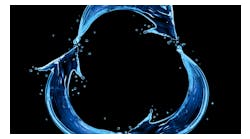Q: Where does bottled water come from, how is it produced and regulated, and how does its quality compare to public drinking water?
A: Numerous types of bottled water are available from several sources, and they are regulated by the federal government, states and the bottled water industry.
Bottled water consumption in the U.S. has been rising consistently since the media increased its coverage of environmental and drinking water issues, such as disinfection byproducts, emerging contaminants, chemical spills and droughts. Every report on the detection of chemicals in drinking water at parts per billion (ppb) or parts per trillion (ppt) levels seems to generate more public concern. Commercial bottled water consumption is common in many parts of the world because of actual or perceived concerns about local drinking water safety, because of taste preferences or as a substitute for soft drinks. Many people occasionally drink bottled water for convenience and taste. Some people claim that they never drink tap water but do drink mineral water or bottled water because of the assumed health benefits.
The public drinking water quality in the U.S. is generally excellent from a health perspective. However, some water supplies have persistent or periodic taste issues that may arise from the use of chlorine disinfection or high total dissolved solids (TDS), and confidence in the local supply can be shaken. Waterborne disease rates are low and have been declining since the full implementation of the Safe Drinking Water Act (SDWA) around 1980. On the other hand, aged infrastructure can affect high-quality water entering a piped distribution system and through contact and can be affected by contact time in aged infrastructure.
People use less than 1 percent of their tap water for drinking and cooking. Most is used for sanitation, washing cars and watering lawns. Many consumers have more discretionary income and more options for drinking water than in the past, ranging from tap water to point-of-use (POU) or point-of-entry (POE) treated water and bottled water. More people are opting to differentiate between beverage water and commodity water.
The bottled water business
Bottled water is big business. Bottled water sales in the U.S. exceeded 10 billion gallons and $12.3 billion in 2013, after some small recession-related declines in 2008 and 2009. Worldwide sales were 70.4 billion gallons and growing. Per capita U.S. consumption was 32 gallons. Mexico’s per capita consumption was about double the U.S. for reasons associated with tap water inconsistencies. Today’s U.S. and worldwide sales are undoubtedly higher. For perspective, the city of Chicago produces more than one billion gallons of public drinking water per day.
About two-thirds of the water is provided in thin-walled polyethylene terephthalate (PET) bottles that are usually blown at the bottling site. A rapidly growing segment is home and office delivery in 5-gallon carboys and bottles. More than 90 percent of U.S. bottled water is still water, so only a small portion is carbonated. About 10 percent of the bottled water total was imported, even though plenty of local product is available. Much of the total is from consumers replacing a portion of fruit juice and soda consumption, which is steadily declining.
From the above, the overall average cost is about $1.23 per gallon, but retail costs for small units are well above that. Undoubtedly most of the cost is for advertising, packaging and transport, and seller profit. Typical tap water costs are approximately 3 to 4 dollars per 1,000 gallons delivered.
Types, sources and treatment
Several types of bottled water, by source and treatment, are described in the following edited International Bottled Water Association (IBWA) definitions:
- Bottled water — water intended for human consumption and sealed in bottles or other containers with no added ingredients except that it may optionally contain safe and suitable antimicrobial agents.
- Sparkling bottled water — bottled water that, after treatment and possible replacement of carbon dioxide, contains the same amount of carbon dioxide present at the emergence from the source.
- Mineral water — water containing no less than 250 parts per million TDS, originating from a geologically and physically protected underground water source. Mineral water can be distinguished from other types of water by its constant level and relative proportions of minerals and trace elements at the point of emergence from the source, taking into consideration the cycles of natural fluctuations. No minerals may be added to this type.
- Natural water — bottled spring water, mineral water, artesian water, artesian well water or well water derived from an underground formation or from surface water that only requires minimal processing. It is not derived from a municipal system or public water supply and is unmodified except for limited treatment (for example, filtration, ozonation or an equivalent disinfection process).
- Spring water — water derived from an underground formation from which water flows naturally to the surface of the Earth. Spring water must be collected only at the spring or through a borehole tapping the underground formation feeding the spring.
- Well water — water from a hole bored, drilled or otherwise constructed in the ground that taps the water of an aquifer.
A large portion of commercial bottled water is produced by reprocessing municipal tap water (for example, Dasani and Aquafina and many others), and the source information can be found on the labels. The municipal water may be treated by reverse osmosis (RO) and ozonation with some minerals added for taste. Therefore, it would have low TDS and total organic carbon. Some assume that water in a bottle must be natural spring water, so disingenuous complaints have been made by some people and organizations who did not read the labels. Retreated tap water’s quality is at least equivalent to "natural" water’s.
Bottled water quality
The Natural Resources Defense Council (NRDC) and some other organizations have occasionally published "exposés" of bottled water quality. In 1999 NRDC issued a report of 185 samples of many bottled waters, which tested for heterotrophic plate counts (HPC), arsenic, trihalomethanes (THMs) and bis 2-ethylhexyl phthalate (DEHP). Arsenic was detected in some natural mineral waters, THMs were detected in a few brands, mostly from one supplier, and DEHP was detected in two samples. HPCs were commonly found and a few were at high levels.
HPCs regrow in water that does not contain a residual disinfectant, so bottled water on the shelf has the potential to grow HPCs even though it has been disinfected with ozone or ultraviolet light, which, however, leave no disinfectant residual. The Food and Drug Administration (FDA) allows HPC in bottled water at high levels and the World Health Organization (WHO) has concluded that they are not generally a health concern. The U.S. Environmental Protection Agency (EPA) has a drinking water treatment technique regulation that limits HPC to 500 bacterial colony units per milliliter.
Standards and regulations
The Codex Alimentarius — a joint activity of the Food and Agricultural Organization (FAO) and WHO — provides international standards for bottled and mineral waters. In the U.S., the FDA establishes drinking water standards for bottled water that is in interstate commerce, so the national brands are federally regulated. By law, FDA standards are derivative of the EPA National Primary Drinking Water Regulation standards and differ in appropriate minor respects. States have the authority to establish standards for bottled water within their borders, and many do.
Bottled waters that exceed FDA quality standards may not be distributed for public consumption or must be recalled from the marketplace. Six reported recalls of bottled water occurred from 1989 to 2011. A 2009 Government Accountability Office survey of state bottled water regulatory authorities reported no outbreaks of foodborne illness from bottled water during a five-year period.
FDA’s current Good Manufacturing Practices (cGMP) regulations include monitoring requirements that are generally more frequent than community water systems, do not allow for averaging of test results, are not related to the number of consumers and are more frequent on a per-gallon basis than tap water requirements.
In addition, IBWA, located in Alexandria, Virginia, has produced a Code of Practice that includes standards, monitoring requirements and good manufacturing practices for its members, which are also periodically subject to on-site inspections and water analyses. The code is more restrictive than FDA and EPA standards in several respects.
Conclusions
Bottled water is a large and growing factor in the U.S. drinking water landscape. Although some may see statements in the press that bottled water is not as highly regulated as public drinking water, that is generally not the case. Assuming it has been produced and bottled under controlled sanitary conditions, bottled water is actually an ideal, though expensive, method for providing drinking water — because it is protected from contamination after being bottled.
Consumers have many drinking water options; so choices are widely available for those willing to pay the price for the convenience and taste preference and, potentially, additional quality control. The SDWA mandates the quality and safety of public tap water, and drinking water standards are becoming more restrictive and expensive to achieve. Since less than 1 percent is consumed in drinking and cooking, one could imagine a water delivery paradigm that would distinguish between beverage water and commodity water. In fact, it would be logical and cost effective if community-supplied bottled water or community-managed POU or POE would be acceptable and more widely available, especially in small communities that are having problems meeting national standards.
Public water suppliers could also provide bottled water from their facilities to consumers — some have tried but it has not caught on. Singapore does it with their NeWater. Perhaps someday the local drinking water supplier will be a full-service water provider by several of those methods.
Dr. Cotruvo is president of Joseph Cotruvo and Associates, LLC, Water, Environment and Public Health Consultants. He is a former director of the U.S. EPA Drinking Water Standards Division.


